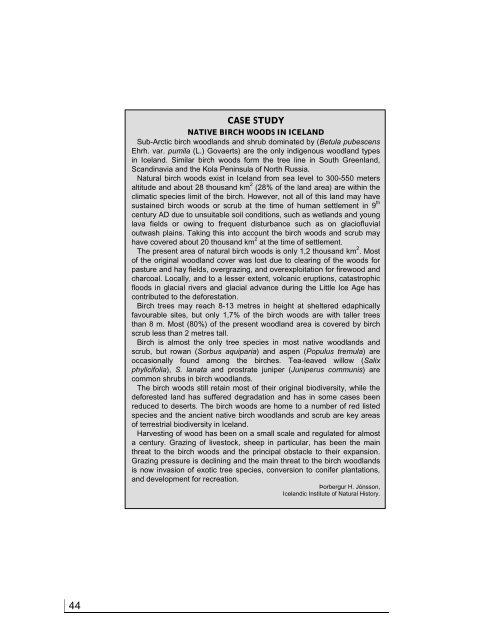BIOLOGICAL DIVERSITY IN ICELAND - Convention on Biological ...
BIOLOGICAL DIVERSITY IN ICELAND - Convention on Biological ...
BIOLOGICAL DIVERSITY IN ICELAND - Convention on Biological ...
- No tags were found...
You also want an ePaper? Increase the reach of your titles
YUMPU automatically turns print PDFs into web optimized ePapers that Google loves.
44CASE STUDYNATIVE BIRCH WOODS <str<strong>on</strong>g>IN</str<strong>on</strong>g> <str<strong>on</strong>g>ICELAND</str<strong>on</strong>g>Sub-Arctic birch woodlands and shrub dominated by (Betula pubescensEhrh. var. pumila (L.) Govaerts) are the <strong>on</strong>ly indigenous woodland typesin Iceland. Similar birch woods form the tree line in South Greenland,Scandinavia and the Kola Peninsula of North Russia.Natural birch woods exist in Iceland from sea level to 300-550 metersaltitude and about 28 thousand km 2 (28% of the land area) are within theclimatic species limit of the birch. However, not all of this land may havesustained birch woods or scrub at the time of human settlement in 9 thcentury AD due to unsuitable soil c<strong>on</strong>diti<strong>on</strong>s, such as wetlands and younglava fields or owing to frequent disturbance such as <strong>on</strong> glaciofluvialoutwash plains. Taking this into account the birch woods and scrub mayhave covered about 20 thousand km 2 at the time of settlement.The present area of natural birch woods is <strong>on</strong>ly 1,2 thousand km 2 .Mostof the original woodland cover was lost due to clearing of the woods forpasture and hay fields, overgrazing, and overexploitati<strong>on</strong> for firewood andcharcoal. Locally, and to a lesser extent, volcanic erupti<strong>on</strong>s, catastrophicfloods in glacial rivers and glacial advance during the Little Ice Age hasc<strong>on</strong>tributed to the deforestati<strong>on</strong>.Birch trees may reach 8-13 metres in height at sheltered edaphicallyfavourable sites, but <strong>on</strong>ly 1,7% of the birch woods are with taller treesthan 8 m. Most (80%) of the present woodland area is covered by birchscrub less than 2 metres tall.Birch is almost the <strong>on</strong>ly tree species in most native woodlands andscrub, but rowan (Sorbus aquiparia) and aspen (Populus tremula) areoccasi<strong>on</strong>ally found am<strong>on</strong>g the birches. Tea-leaved willow (Salixphylicifolia), S. lanata and prostrate juniper (Juniperus communis) arecomm<strong>on</strong> shrubs in birch woodlands.The birch woods still retain most of their original biodiversity, while thedeforested land has suffered degradati<strong>on</strong> and has in some cases beenreduced to deserts. The birch woods are home to a number of red listedspecies and the ancient native birch woodlands and scrub are key areasof terrestrial biodiversity in Iceland.Harvesting of wood has been <strong>on</strong> a small scale and regulated for almosta century. Grazing of livestock, sheep in particular, has been the mainthreat to the birch woods and the principal obstacle to their expansi<strong>on</strong>.Grazing pressure is declining and the main threat to the birch woodlandsis now invasi<strong>on</strong> of exotic tree species, c<strong>on</strong>versi<strong>on</strong> to c<strong>on</strong>ifer plantati<strong>on</strong>s,and development for recreati<strong>on</strong>.Þorbergur H. Jónss<strong>on</strong>,Icelandic Institute of Natural History.
















